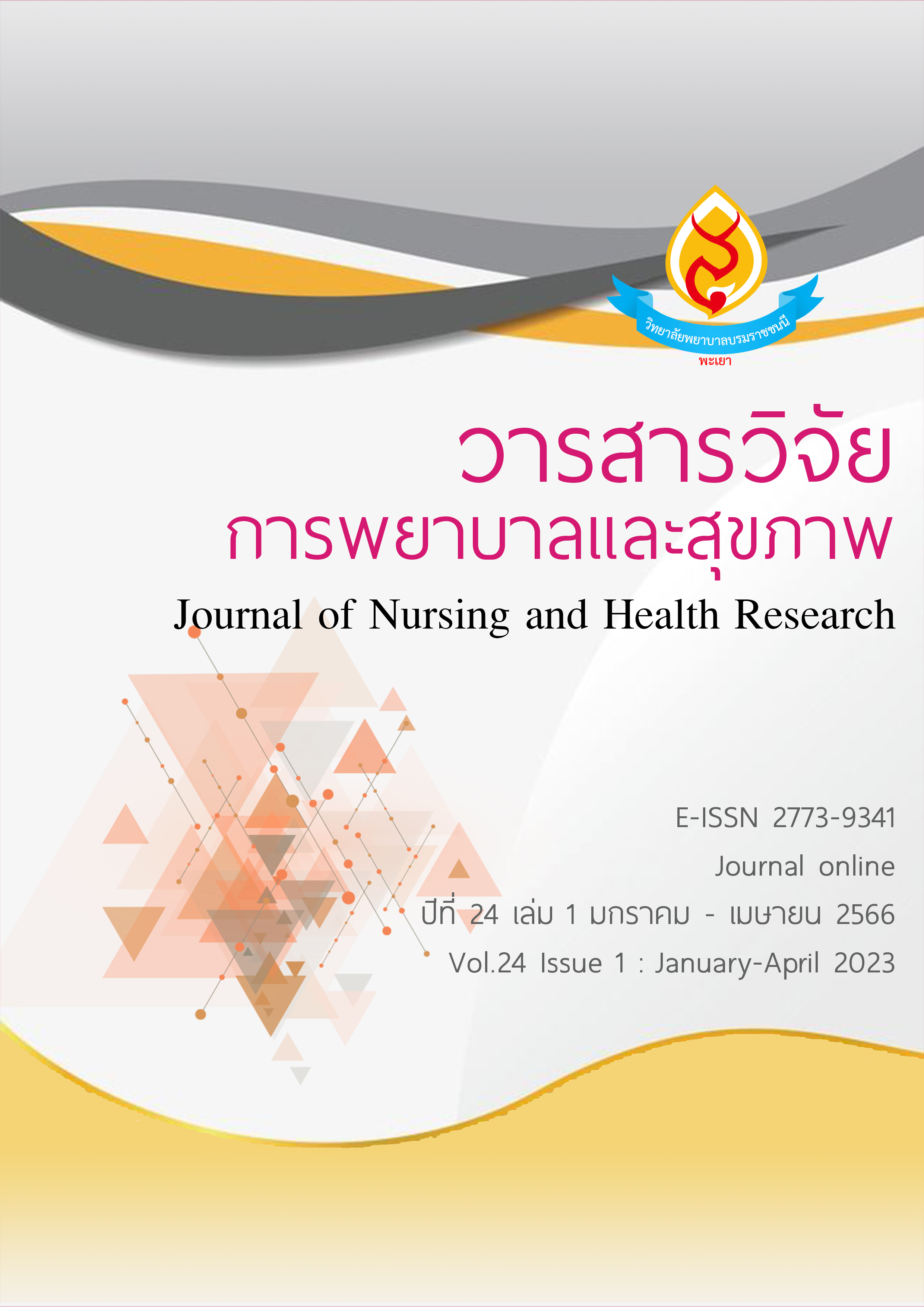ประสิทธิผลการใช้แนวปฏิบัติการพยาบาลผู้ป่วยโรคเบาหวานขึ้นจอตาที่ได้รับการฉีดยาอวาสติน ต่ออาการปวด ความรู้เกี่ยวกับการปฏิบัติตัว และความพึงพอใจต่อการใช้แนวปฏิบัติ
คำสำคัญ:
ประสิทธิผล, แนวปฏิบัติทางคลินิก, การดูแลผู้ป่วยโรคเบาหวานขึ้นจอตา, การฉีดยาอวาสตินเข้าน้ำวุ้นตาบทคัดย่อ
การนำแนวปฏิบัติการพยาบาลมาใช้ในการพยาบาลผู้ป่วยโรคเบาหวานขึ้นจอตาที่ได้รับการฉีดยาอวาสติน
มีความสำคัญต่อผู้ป่วยเป็นอย่างยิ่ง การวิจัยกึ่งทดลองนี้มีวัตถุประสงค์เพื่อเปรียบเทียบประสิทธิผลของการใช้แนวปฏิบัติ
การพยาบาลผู้ป่วยโรคเบาหวานขึ้นจอตา ที่ได้รับการฉีดยาอวาสตินเข้าน้ำวุ้นตา ต่อความเจ็บปวด ความรู้เกี่ยวกับ
การปฏิบัติตัว และความพึงพอใจต่อการใช้แนวปฏิบัติ กลุ่มตัวอย่างเป็นผู้ป่วยโรคเบาหวานขึ้นจอตาและนัดมารับ
การฉีดยาอวาสตินเข้าน้ำวุ้นตา จำนวน 100 ราย คัดเลือกโดยสุ่มกลุ่มตัวอย่างออกเป็น 2 กลุ่มโดยการจับฉลาก เครื่องมือที่ใช้ในการเก็บข้อมูลประกอบด้วย แบบบันทึกข้อมูลส่วนบุคคล แบบประเมินระดับความเจ็บปวด โดยมีค่าความเชื่อมั่นจากการสังเกต เท่ากับ 1 แบบสอบถามความรู้การปฏิบัติตัวหลังฉีดยาอวาสตินเข้าน้ำวุ้นตา มีค่าความเชื่อมั่นโดยใช้สูตรของคูเดอร์-ริชาร์ดสัน 20 เท่ากับ .78 และแบบสอบถามความพึงพอใจของผู้ป่วยที่ใช้แนวปฏิบัติโรคเบาหวานขึ้นจอตา มีค่าความเชื่อมั่นของสัมประสิทธิ์อัลฟ่าของครอนบาค เท่ากับ .97 วิเคราะห์ข้อมูลด้วยสถิติ ความถี่ ร้อยละ และส่วนเบี่ยงเบนมาตรฐาน และวิเคราะห์เปรียบเทียบค่าเฉลี่ยใช้สถิติ วิลคอกซันแมชแพร์ไซจน์แรงค์ และสถิติ แมนวิทนีย์ ยู ผลการวิจัย พบว่า หลังการใช้แนวปฏิบัติ กลุ่มทดลองมีคะแนนความเจ็บปวดน้อยกว่า
กลุ่มควบคุมและมีคะแนนความรู้และความพึงพอใจสูงกว่ากลุ่มควบคุมอย่างมีนัยสำคัญทางสถิติ (p<.001) ผลการวิจัยนี้จะเป็นข้อมูลสำหรับพยาบาลในการตัดสินใจในการใช้แนวปฏิบัติในการดูแลผู้ป่วยโรคเบาหวานขึ้นจอตาที่ได้รับการฉีดยาอวาสตินต่อไป
เอกสารอ้างอิง
จุฬาภรณ์ ศรีเมือง. (2565). ผลของการใช้โปรแกรมการให้ข้อมูลอย่างมีแบบแผนร่วมกับสื่อวีดีทัศน์ต่อความรู้และความวิตกกังวล ในผู้ป่วยระยะเตรียมการผ่าตัดต่อมไทรอยด์แผนกหู คอ จมูก โรงพยาบาลอุดรธานี. วารสารการแพทย์โรงพยาบาลอุดรธานี, 30(3), 387-398.
มะลิ การะปักษ์, อรพิน มโนรส, จันทิรา ชัยสุขโกศล และเพ็ญศรี ปัญโญ. (2564). ผลของการใช้แนวปฏิบัติในการดูแลผู้ป่วยโรคจอตาที่ได้รับการฉีดยาอวาสตินเข้าน้ำวุ้นตา ในหอผู้ป่วยจักษุ โสต ศอ นาสิก โรงพยาบาลแพร่. วารสารโรงพยาบาลแพร่, 29(1), 153-166.
รัตนา ค้าขาย และ ภาวนา ดาวงศ์ศรี. (2565). ผลของการใช้ โปรแกรมการให้ข้อมูลการสร้างแรงจูงใจและการพัฒนาทักษะการใช้ยาหยอดตาต่อพฤติกรรมความร่วมมือในการรักษาของผู้ป่วยสูงอายุโรคต้อหิน โรงพยาบาลอุดรธานี. วารสารการแพทย์โรงพยาบาลอุดรธานี, 30(3), 420-434.
ศิริวรรณ วรรณศิริ, มุกดา เดชประพนธ์ และภฤศ หาญอุตสาหะ. (2563). ผลของโปรแกรมการให้ความรู้ และการส่งเสริมพฤติกรรมการดูแลตนเองเพื่อป้องกันการเกิดโรคเบาหวานขึ้นจอประสาทตาต่อผลลัพธ์ทางคลินิกในผู้ป่วยโรคเบาหวาน. วารสารการปฏิบัติการพยาบาลและการผดุงครรภ์ไทย, 7(2), 57-75
สมใจ แสงสร้อย. (2562). การพยาบาลผู้ป่วยเบาหวานที่มีภาวะเบาหวานขึ้นจอตา. วารสารสำนักงานสาธารณสุขจังหวัดขอนแก่น, 1(2), 197-208.
สิริรักษ์ เกตุจินดา, วัลภา คุณทรงเกียรติ และภาวนา กีรติยุตวงศ์. (2552). ผลของแนวปฏิบัติการพยาบาลเพื่อจัดการกับความปวดสำหรับผู้ป่วยผ่าตัดช่องท้องต่อความปวดและความพึงพอใจในการจัดการกับความปวด.วารสารคณะพยาบาลศาสตร์ มหาวิทยาลัยบูรพา, 17(1), 39-51.
สุชีรา อึ้งตระกูล, อำภาพร นามวงศ์พรหม และน้ำอ้อย ภักดีวงศ์. (2555). ผลของการใช้แนวปฏิบัติการดูแลผู้ป่วยผ่าตัดทางเบี่ยงหลอดเลือดหัวใจต่อจำนวนวันนอนหลังผ่าตัดและความพึงพอใจของผู้ป่วย. วารสารพยาบาลโรคหัวใจและทรวงอก, 23(2), 31-42.
หน่วยเวชระเบียนและสถิติ โรงพยาบาลมหาราชนครเชียงใหม่. (2565). รายงานสถิติประจำปี. เชียงใหม่: โรงพยาบาลมหาราชนครเชียงใหม่
อัจฉรา แก้วน้ำเชื้อ. (2564). การพยาบาลผู้ป่วยโรคเบาหวานขึ้นจอประสาทตา. วารสารสุขภาพและสิ่งแวดล้อมศึกษา, 6(4), 177-180.
Ansari, P., Tabasumma, N., Snigdha, N. N., Siam, N. H., Panduru, R. V., Azam, S., ... & Abdel-Wahab, Y. H. (2022). Diabetic retinopathy: an overview on mechanisms, pathophysiology and pharmacotherapy. Diabetology, 3(1), 159-175.
Cho, N. H., Shaw, J. E., Karuranga, S., Huang, Y., da Rocha Fernandes, J. D., Ohlrogge, A. W., … Malanda, B. I. D. F. (2018). IDF diabetes Atlas: Global estimates of diabetes prevalence for 2017 and projections for 2045. Diabetes Research and Clinical Practice, 138, 271-281
Eccleston, C., & Crombez, G. (1999). Pain demands attention: a cognitive - affective model of the interruptive function of pain. Psychological Bulletin, 125(3), 356.
Flynn Jr, H. W & Batra, N. R. (2018). Clinical trials in diabetic retinopathy. Miami: Bascom Palmer Eye Institute.
Happich, M., Reitberger, U., Breitscheidel, L., Ulbig, M., & Watkins, J. (2008). The economic burden of diabetic retinopathy in Germany in 2002. Graefe's Archive for Clinical and Experimental Ophthalmology, 246, 151-159.
Hooper P., Boucher, M., Cruess, A., Dawson, K. G., Delpero, W., Greve, M., … Maberley, D. A. (2012). Canadian ophthalmological society evidence-based clinical practice guidelines for the management of diabetic retinopathy. Canadian Journal of Ophthalmology, 47(2), 1-54.
Kadimpati, S., Zale, E. L., Hooten, M. W., Ditre, J. W., & Warner, D. O. (2015). Associations between neuroticism and depression in relation to catastrophizing and pain-related anxiety in chronic pain patients. PLoS One, 10(4), e0126351.
McCaffery, M., & Beebe, A. (1989). Pain: clinical manual for nursing practice. Mosby St. Louis, MO.
National Health and Medical Research Council. (2020). A guide to the development, implementtation and evaluation of clinical practice guidelines. Retrieved from https://www.health.qld.gov.au/__data/assets/pdf
Pereira, D. M., Shah, A., D’Souza, M., Simon, P., George, T., D’Souza, N., ... & Baliga, M. S. (2017). Quality of life in people with diabetic retinopathy: Indian study. Journal of Clinical and Diagnostic Research, 11(4), NC01.
Rischer, K. M., González-Roldán, A. M., Montoya, P., Gigl, S., Anton, F., & van der Meulen, M. (2020). Distraction from pain: the role of selective attention and pain catastrophizing. European Journal of Pain (London, England), 24(10), 1880-1891.
Rischer, K. M., Savallampi, M., Akwaththage, A., Salinas Thunell, N., Lindersson, C., & MacGregor, O. (2020). In context: emotional intent and temporal immediacy of contextual descriptions modulate affective ERP components to facial expressions. Social Cognitive and Affective Neuroscience, 15(5), 551-560.
Safwat, A., Mohamed, R., Abdullah, I., & Abdulmutalib, M. (2021). Effect of nursing guidelines on improving knowledge and relieve anxiety of diabetic patients with retinopathy. International Journal of Novel Research in Healthcare and Nursing, 5(2), 147-157.
Wells, J. A., Glassman, A. R., Jampol, L. M., Aiello, L. P., Antoszyk, A. N., Baker, C. W., ... Diabetic Retinopathy Clinical Research Network. (2016). Association of baseline visual acuity and retinal thickness with 1-year efficacy of aflibercept, bevacizumab, and ranibizumab for diabetic macular edema. JAMA Ophthalmology, 134(2), 127-134.
ดาวน์โหลด
เผยแพร่แล้ว
รูปแบบการอ้างอิง
ฉบับ
ประเภทบทความ
สัญญาอนุญาต
ลิขสิทธิ์ (c) 2023 วารสารวิจัยการพยาบาลและสุขภาพ

อนุญาตภายใต้เงื่อนไข Creative Commons Attribution-NonCommercial-NoDerivatives 4.0 International License.



